What to Know
- The USS Tripoli, commissioned in July of 2020, made its maiden port visit to San Francisco just ahead of Fleet Week 2021, to honor the fallen on the 20th commemoration of 9/11
- The Tripoli is one of the Navy's largest ships, accommodating over a thousand sailors and up to a thousand Marines during air operations
- Helicopters and short-takeoff jets can operate from the Tripoli's flight deck, and the ship can also perform humanitarian aid with its on-board hospital and its robust capacity to make drinking water
The Golden Gate Bridge was shrouded in chilly fog on the afternoon of September 11, 2021 as San Francisco's fireboat, the St. Francis, sat waiting at the mouth of the Bay for the dark object on the horizon to approach.
The firefighters aboard the St. Francis had come to welcome a special visitor: The Navy's newest amphibious assault carrier, the USS Tripoli, with more than a thousand sailors in their white uniforms standing around the edges of the ship's enormous deck.
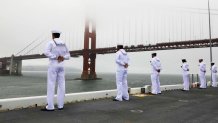
Get a weekly recap of the latest San Francisco Bay Area housing news. Sign up for NBC Bay Area’s Housing Deconstructed newsletter.
"We call it manning the rails," explained Chief Petty Officer Jerome Dunkley, who's in charge of flight deck operations. "It was 9/11, so we were giving honors to the fallen, and also for the city."
Though it came several weeks early, the Tripoli's maiden port visit to San Francisco added an exclamation point to the announcement that S.F. Fleet Week would proceed as scheduled the first week in October — the only Fleet Week in the country to happen in 2021. The ship's crew also took part in disaster preparedness training with Bay Area first responders.
"What makes our ship so unique is we can do assaults if we need to, but we can also do humanitarian assistance and disaster response," said Navy Lt. Sam Lieber. "We have a unique ability to create a lot of water — potable water for drinking. We also have a very robust medical capability on board."
The Tripoli's on-board hospital is second in size only to the Navy's dedicated hospital ships. And the ship as a whole is one of the Navy's largest, second only to supercarriers like the USS Nimitz.

Despite its imposing size, the Tripoli has no catapults for launching jets. Its 844-foot, heat-resistant flight deck is purpose-built to accommodate a new generation of Marine Corps aircraft that are capable of short or vertical takeoff and landing. Currently, it operates as a platform for MV-22 Osprey tilt-rotor aircraft and F-35B Lightning II fighter jets — and has sleeping and dining accommodations for the hundreds of Marines who come with them.
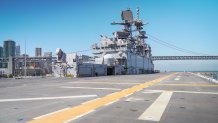
"I'm a high-energy guy," Dunkley said as he stood on the flight deck. "I can't stay still, so I like being up here because it constantly keeps you on your feet, constantly keeps you busy."
Local
Dunkley showed us the red and white "foul line" behind which air operations personnel must stand for their own safety when jets and helicopters are taking off.
"You do not want to be standing here when that aircraft is taking off," he said. "It's gonna blow you back."
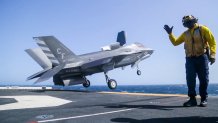
Directly below the flight deck, the Tripoli's massive hangar bay is where aviation mechanics are typically shuffling aircraft around, performing light maintenance on the ones toward the front of the ship, and more complicated repairs on the ones toward the rear. But when the ship is in port, it carries just a solitary, battered airplane covered in duct tape.
"This guy's just for training purposes — there's no engine in it, it's just here so we can use it to practice," Dunkley explained. "We have to constantly train, train, train, that's the only way we get better. ... The guys have to be proficient moving them around the hangar bay because it's a tight space."
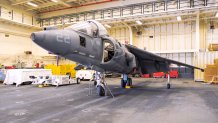
The ship is filled with tight spaces, including narrow hallways punctuated by tightly-sealed doors that not only can stop fire and flooding, but also help control the flow of air conditioning. Savvy sailors can tell where they are on the ship by decoding the cryptic clusters of letters and numbers printed on many of the ship's beige interior walls.
"We call that the bullseye," Lieber said. "Those are all over the place. Every space will have one."
Another common sight aboard the ship: fire hoses.
"That is because at sea, we are our own fire department," Lieber said. "We can't call anyone for help, so all sailors are trained in some basic level of damage control, whether it be fire, flooding or even toxic gas. But we do also have our own little fire department on board."
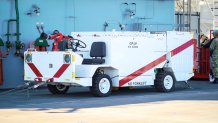
Back up on the flight deck, Dunkley showed us the ship's fire truck — a compact and boxy white vehicle with red stripes that carries an ample supply of both water and firefighting foam.
"It's as powerful as you'll ever get," Dunkley said. "It's fast!"
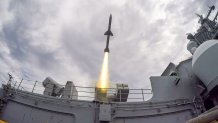
But aside from water and foam to fight fires, and fuel to power the aircraft, there's another important liquid aboard the Tripoli: coffee. For officers like Lt. Lieber, coffee is found in the ship's wardroom — a combined dining room and meeting space that's right next to the officers' on-board barbershop. Lieber says drinking the ship's coffee is a rite of passage for visitors aboard the Tripoli, and a veritable necessity for the sailors stationed on board.
"These guys work really hard to make sure the coffee's always hot so people can keep working around the clock," Lieber said of the ship's large culinary staff. "Because somebody's always working on a ship. A ship is never asleep."
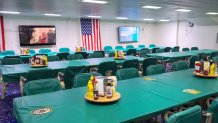
Though the sailors couldn't disclose where they'll head next, it's likely to be the ship's first time there. That's the fun of being on a brand new ship, Lieber said.
"It's something we'll be able to tell our kids and grandkids and family and friends years from now, 'Hey, the first time that ship went there, I was there,'" he said. "I'm looking forward to all the exciting places she'll go, and I can't wait to be a part of that."



